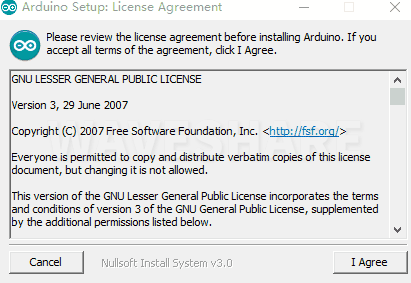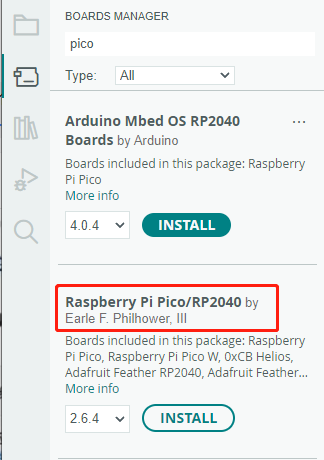Difference between revisions of "RP2040-Touch-LCD-1.28"
m (Text replacement - "Service00" to "Servicebox1") |
|||
| Line 106: | Line 106: | ||
*[https://github.com/raspberrypi/pico-micropython-examples Official Raspberry Pi Micropython Demo (GitHub)] | *[https://github.com/raspberrypi/pico-micropython-examples Official Raspberry Pi Micropython Demo (GitHub)] | ||
{{Raspberry Pi Pico Software}} | {{Raspberry Pi Pico Software}} | ||
| − | {{ | + | {{Servicebox1}} |
Revision as of 06:44, 16 August 2023
| ||
Overview
Introduction
RP2040-Touch-LCD-1.28 is a low-cost, high-performance MCU board designed by Waveshare, tiny size, with an onboard 1.28inch capacitive touch display, Li-ion battery recharge manager, 6-axis sensor (3-axis accelerometer and 3-axis gyroscope), and so on, which makes it easy for you to develop and integrate it into products quickly.
Feature
- RP2040 microcontroller chip designed by Raspberry Pi in the United Kingdom.
- Dual-core Arm Cortex M0+ processor, flexible clock running up to 133 MHz.
- 264KB of SRAM, and 4MB of onboard Flash memory.
- Type-C connector, keeps it up to date, easier to use.
- Onboard 1.28inch capacitive touch display, 240×240 resolution, 65K color.
- Lithium battery recharge/discharge header, suitable for mobile devices.
- USB 1.1 with device and host support.
- Low-power sleep and dormant modes.
- Drag-and-drop programming using mass storage over USB.
- Accurate clock and timer on-chip.
- Temperature sensor.
- 6 × GPIO pin via SH1.0 connector.
Specification
| LCD Parameters | |||
| Touch Chip | CST816S | Touch Port | I2C |
| Display Chip | GC9A01A | Display Interface | SPI |
| Resolution | 240(H) RGB x 240(V) | Display Size | Φ32.4mm |
| Display Panel | IPS | Pixel Pitch | 0.135(H)x 0.135(V)mm |
| IMU Parameters | |||
| Sensor | QMI8658C | ||
| Accelerometer | Resolution: 16 bits Measuring Range (Optional): ±2, ±4, ±8 ±16g | ||
| Gyroscope | Resolution: 16 bits Measuring Range (Optional): ±16, ±32, ±64, ±128, ±256, ±512, ±1024, ±2048°/sec | ||
Note
The touch sensitivity on the edge of the round screen is decreased due to its round shape design.
Pinout
Dimensions
Pico Quick Start
Download Firmware
- MicroPython Firmware Download
- C_Blink Firmware Download
Video Tutorial
- Pico Tutorial I - Basic Introduction
- Pico Tutorial II - GPIO
- Pico Tutorial III - PWM
- Pico Tutorial IV - ADC
- Pico Tutorial V - UART
- Pico Tutorial VI - To be continued...
MicroPython Series
- 【MicroPython】 machine.Pin Function
- 【MicroPython】 machine.PWM Function
- 【MicroPython】 machine.ADC Function
- 【MicroPython】 machine.UART Function
- 【MicroPython】 machine.I2C Function
- 【MicroPython】 machine.SPI Function
- 【MicroPython】 rp2.StateMachine
C/C++ Series
Arduino IDE Series
Install Arduino IDE
-
Download the Arduino IDE installation package from Arduino website.

-
Just click on "JUST DOWNLOAD".

-
Click to install after downloading.

-
Note: You will be prompted to install the driver during the installation process, we can click Install.
Install Arduino-Pico Core on Arduino IDE
-
Open Arduino IDE, click the File on the left corner and choose "Preferences".

-
Add the following link in the additional development board manager URL, then click OK.
https://github.com/earlephilhower/arduino-pico/releases/download/global/package_rp2040_index.json

Note: If you already have the ESP8266 board URL, you can separate the URLs with commas like this:https://dl.espressif.com/dl/package_esp32_index.json,https://github.com/earlephilhower/arduino-pico/releases/download/global/package_rp2040_index.json
-
Click on Tools -> Dev Board -> Dev Board Manager -> Search for pico, it shows installed since my computer has already installed it.


Upload Demo At the First Time
-
Press and hold the BOOTSET button on the Pico board, connect the Pico to the USB port of the computer via the Micro USB cable, and release the button when the computer recognizes a removable hard drive (RPI-RP2).

- Download the demo, open arduino\PWM\D1-LED path under the D1-LED.ino.
-
Click Tools -> Port, remember the existing COM, do not need to click this COM (different computers show different COM, remember the existing COM on your computer).

-
Connect the driver board to the computer with a USB cable, then click Tools -> Ports, select uf2 Board for the first connection, and after the upload is complete, connecting again will result in an additional COM port.

-
Click Tool -> Dev Board -> Raspberry Pi Pico/RP2040 -> Raspberry Pi Pico.

-
After setting, click the right arrow to upload.

- If you encounter problems during the period, you need to reinstall or replace the Arduino IDE version, uninstall the Arduino IDE needs to be uninstalled cleanly, after uninstalling the software you need to manually delete all the contents of the folder C:\Users\[name]\AppData\Local\Arduino15 (you need to show the hidden files in order to see it) and then reinstall.
Open Source Demo
- MicroPython Demo (GitHub)
- MicroPython Firmware/Blink Demo (C)
- Official Raspberry Pi C/C++ Demo
- Official Raspberry Pi MicroPython Demo
- Arduino Official C/C++ Demo
Resource
Demo
Schematic
3D Drawing
Datasheet
Official Resources
Raspberry Pi Doecument
- Raspberry Pi Pico Learning MicroPython Programming Books
- Related Raspberry Pi Books Download
- Raspberry Pi Pico Schematic
- Pico Pinout
- Pico
- Pico C SDK User Manual
- Pico Python SDK User Manual
- Pico Datasheet
- RP2040 Datasheet
- RP2040 Hardware Design Manual
Raspberry Pi Open-source Demo
Development Software
Technical Support
If you need technical support or have any feedback/review, please click the Submit Now button to submit a ticket, Our support team will check and reply to you within 1 to 2 working days. Please be patient as we make every effort to help you to resolve the issue.
Working Time: 9 AM - 6 AM GMT+8 (Monday to Friday)




